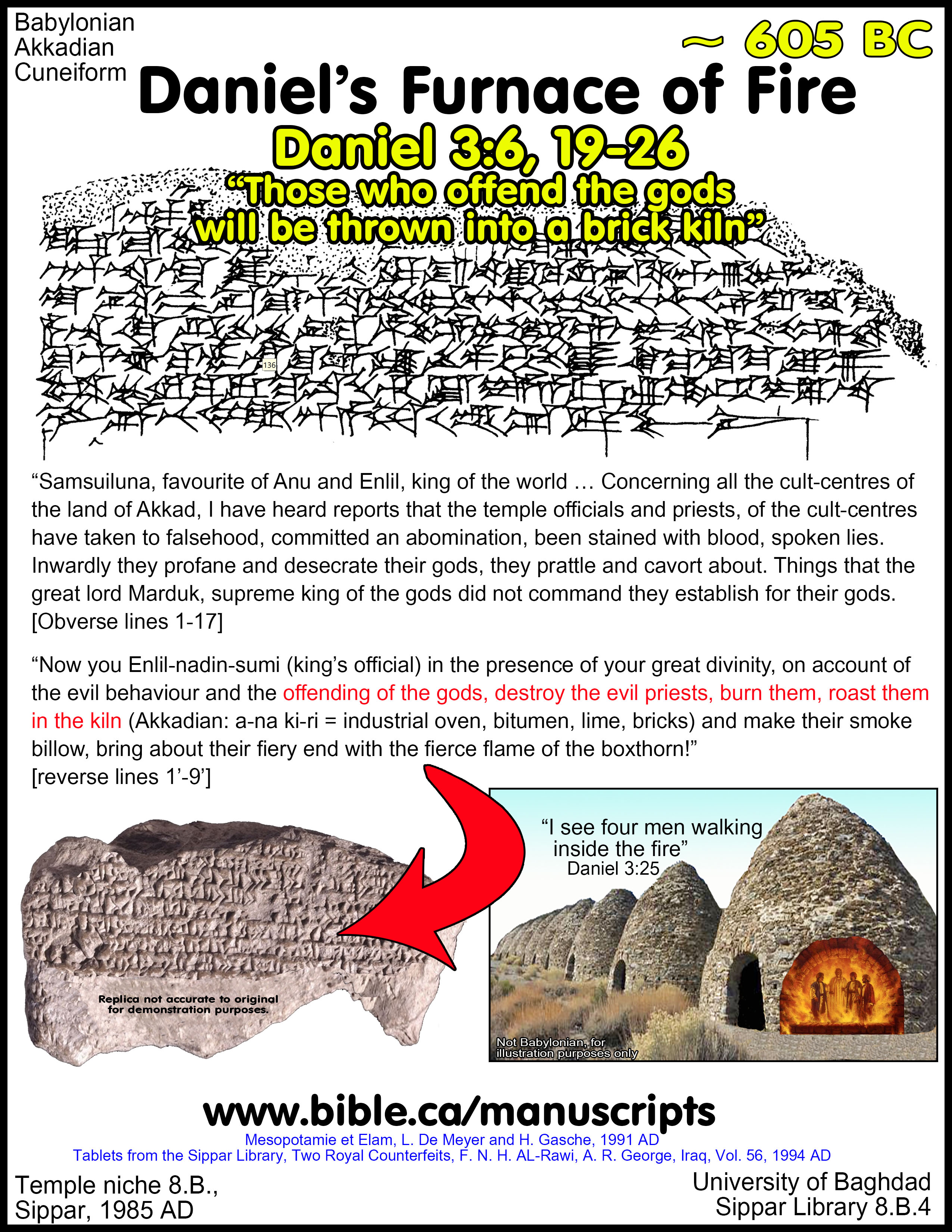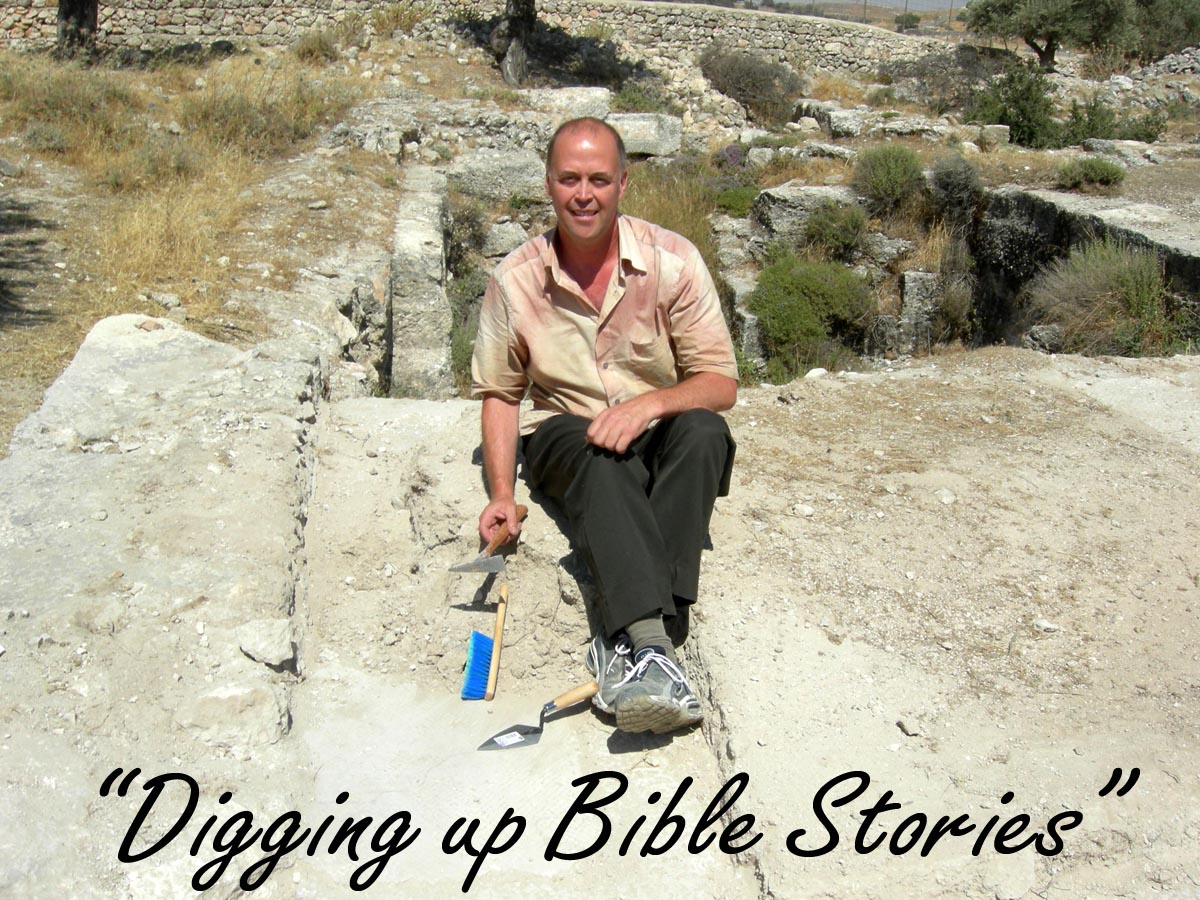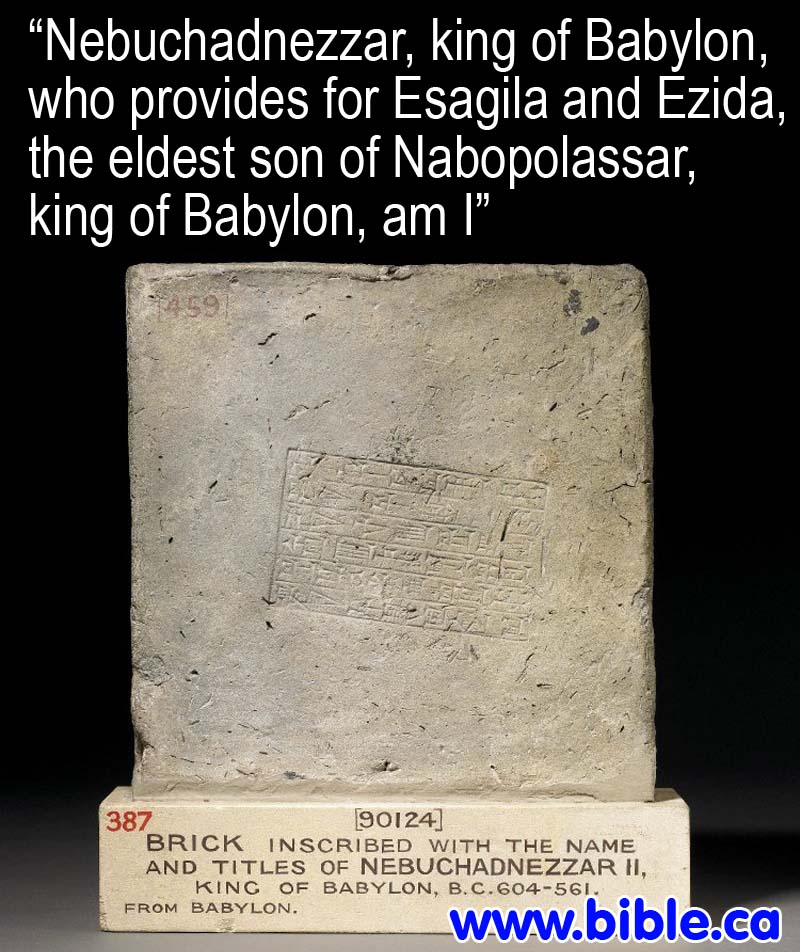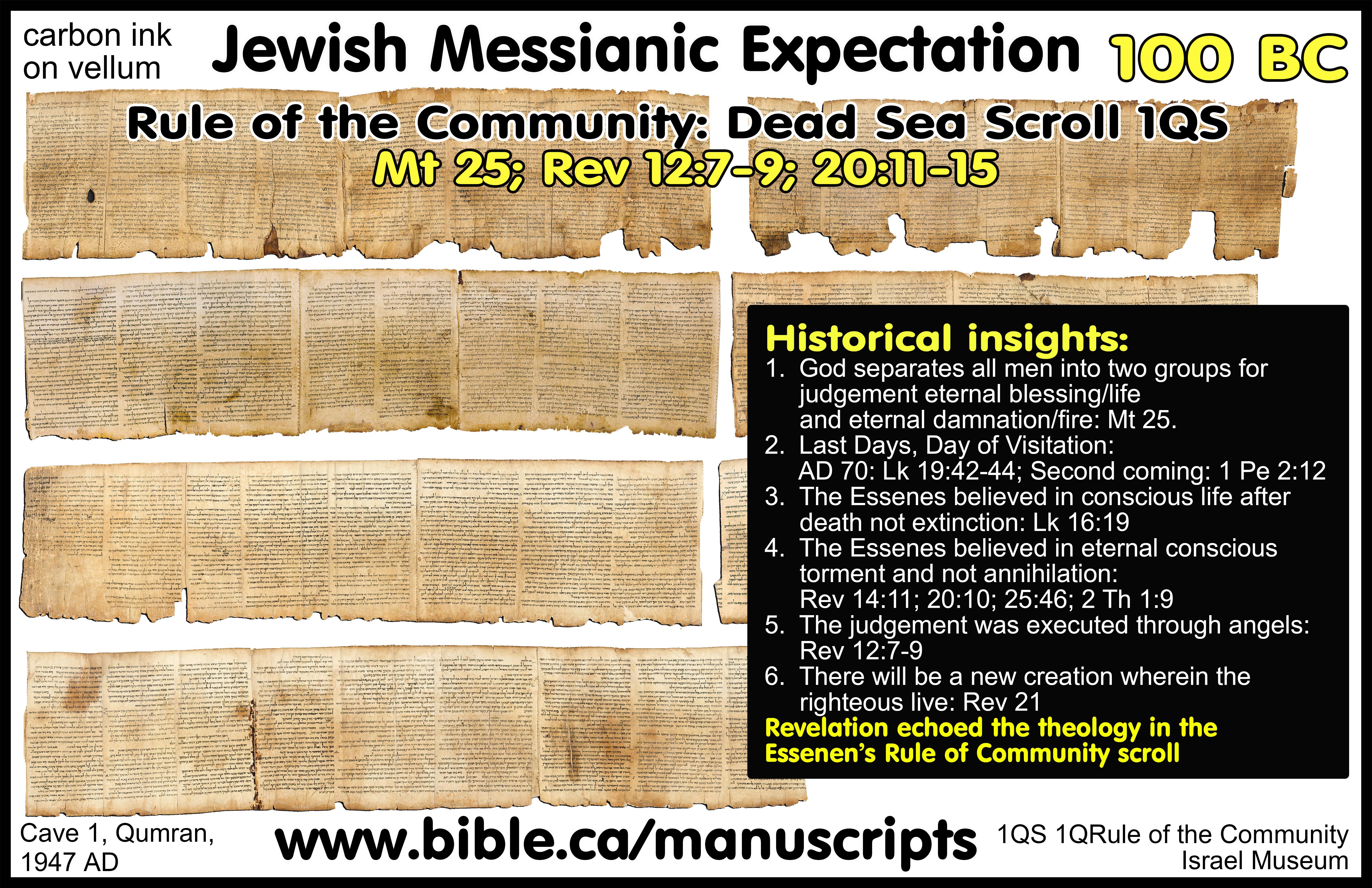Archeology of Daniel: Akkadian tablet from 605 BC
Daniel’s Furnace of Fire: Shadrach, Meshach and Abed-nego: 594 BC
Scripture: Daniel 3
|
Digging up Bible stories! A Babylonian tablet dating from the time of Nebuchadnezzar decreed that if you offend the gods, you will be cast into a commercial oven like a brick kiln. This directly confirms the story of Daniel 3 where Shadrach, Meshach and Abed-nego where cast into a brick kiln in the spring of 594 BC. This proves Daniel was written in the 6th century BC, not 150 BC as the skeptics suggest because execution in an industrial kiln was unknown during the Hasmonean era.
"What you read in the book you find in the ground" |
Introduction:
1. An Akkadian cuneiform tablet purported to be written by Samsu-iluna, king of Babylonian (1750–1712 BC) issued a decree that if you offend the gods, you will be cast into an industrial oven. The Akkadian word for oven used in line 6’ (reverse) is “a-na ki-ri” and refers to an industrial oven or kiln, that utilized bitumen to produce lime and fire mud bricks.
2. The document is pseudepigraphal, purporting to be written by Samsu-iluna in 1750 BC, but three indicators prove the document was written during the reign of Nebuchadnezzar after 605 BC. Either way, the tablet directly confirms the Babylonian practice of being thrown into an industrial kiln if you offend the gods as recorded in Daniel 3 when Shadrach, Meshach and Abed-nego were thrown into a brick kiln in the spring of 594 BC. A few months before the Daniel 3 incident, in 595/594 BC, false prophets Ahab and Kolaiah were thrown into the brick kiln by Nebuchadnezzar in the presence of Judean exiles: Jer 29:21. Notably, Daniel, Shadrach, Meshach and Abed-nego had all surrendered to Nebuchadnezzar voluntarily in 605 BC and were the “spiritual cream of the crop”: Daniel 1:7; Jer 21:9; 38:2.
3. Nebuchadnezzar’s image was sixty cubits high and six cubits wide (Daniel 3:1). Construction began 602 BC and was completed 7 years later in 595 BC. Given the cubit in the days of Nebuchadnezzar was 18 inches, this means the image was 9 feet wide by 90 feet high. This is an odd and unstable structure without a massive foundation and strong reinforcements. It was likely a 9 foot wide square column of bricks with a golden image place on the 90 foot top.
4. Nebuchadnezzar boasted he built Babylon and archeology confirms this. Nebuchadnezzar produced over 15 million bricks stamped with his name in huge brick kilns. “The king reflected and said, ‘Is this not Babylon the great, which I myself have built as a royal residence by the might of my power and for the glory of my majesty?’" (Daniel 4:30) Archaeological evidence that confirms Daniel 4:30: One of 15 million fired brick of Nebuchadnezzar:
5. More important, this tablet proves Daniel was written in the 6th century BC, not 150 BC as the skeptics suggest because execution in an industrial kiln was unknown during the Hasmonean era.
6. Amazing that from chronology, Zedekiah was present and bowed down. Nebuchadnezzar called Zedekiah (Daniel 3:27) to the furnace of fire and decreed that anybody who says anything against YHWH would be cast into the brick kiln. It must have been embarrassing and humiliating for Zedekiah, who sat on the throne of YHWH, to have faithlessly bowed to the pagan idol, and witness Nebuchadnezzar praise his three expatriates who had voluntarily walked out of Jerusalem and surrendered to him in 605 BC following the instructions of Jeremiah 21:9; 38:2. To Zedekiah, Danial, Shadrach, Meshach and Abed-nego were traitors, but now Zedekiah was the traitor to God and the deserters were being praised by a pagan Babylonian king as heroes.
What you read in the book you find in the ground!
I. Translations:
1. Translation:
a. “To Enlil-nadin-sumi, the governor of the land, [ ... ] ... , son of "the loins of princeship" [ ... ,] superintendent of[the cult-centres ( of the land)] of Akkad, as many as there are, say: thus [Samsu-iluna,] king of the world, [ ... ] - Thus for the stele: "Concerning all the cult-centres of the land of Akkad, all of those [which,] 5 from east to west I have given entirely into your contrai, I have heard (reports): the temple officials, collegium, néiakku-priests, paiTiu-priests, and dingirgubbu-priests of the cult-centres of the land of Akkad, as many as there are, have taken to falsehood, committed an abomination, been stained with blood, 10 spoken untruths. Inwardly they profane and desecrate their gods, they prattle and cavort about. Things that their gods did not command they establish for their gods. After the great lord Marduk, supreme king of the gods, prince of his brothers, created gods and mankind and allotted them their destiny, he [had] the purifying exorcist, for the well-being of the [numerous] people, and 15 the lamentation [priest, for] the appeasement of the heart, [learn] prognostications, the rite of intercession, and lamentations ... (long lacuna) [' ... ] Nuska [ ... ] did not annul for [them ... ,] did not avert from them evil [portents.] 5' You now, in the presence of your great divinity, on account of evil behaviour and the abomination of the gods, destroy them, burn them, roast them, ... to the cook's oven ... make their smoke billow, bring about their fiery end with the fierce flame of the boxthorn (i.e., red berry colour like fire)!' " Then let the paiziu-priests of Babylonia, all that there are, see and learn, let them become afraid, let them speak to me, Samsu-iluna, the mighty king, favourite of Anu and Enlil!” (Translation: Tablets from the Sippar Library, Two Royal Counterfeits, F. N. H. AL-Rawi, A. R. George, Iraq, Vol. 56, p, 138, 1994 AD)
2. Steven Rudd paraphrase of the tablet:
a. “Samsu-iluna, favourite of Anu and Enlil, king of the world … Concerning all the cult-centres of the land of Akkad, I have heard reports that the temple officials and priests, of the cult-centres have taken to falsehood, committed an abomination, been stained with blood, spoken lies. Inwardly they profane and desecrate their gods, they prattle and cavort about. Things that the great lord Marduk, supreme king of the gods did not command they establish for their gods. [Obverse lines 1-17]
b. “Now you Enlil-nadin-sumi (king’s official) in the presence of your great divinity, on account of evil behaviour and the abomination of the gods, destroy them (sinful priests), burn them, roast them in the kiln (Akkadian: a-na ki-ri = industrial oven, bitumen, lime, bricks) and make their smoke billow, bring about their fiery end with the fierce flame of the boxthorn!” [reverse lines 1’-9’]
II. Evidence the tablet is Pseudepigraphal:
Samsu-iluna was a Babylonian king 1750–1712 BC, but the tablet was written during the reign of Nebuchadnezzar who reigned 605-539 BC. The document was written 1100 years later than what it purports.
1. The title of governor “sakin tem miiti” in line 1 is the most obvious anachronism because it did not come into use until 200 years after Samsu-iluna had died. "The office of sakin temi originates in the Kassite period (1531-1155 BC). Up until the middle of the ninth century, the sakin remi seems to have been a rather minor provincial official ... A possible variant of this office, sikin rem(i) mati, occurs several times in Babylonia between the late twelfth and the late ninth centuries." (Political history of Post-Kassite Babylonia 1158-722 BC, J. A. Brinkman, p307, 1968 AD)
2. Another obvious anachronism are the praise epithets lavished on Marduk, which include "king of the gods" and attribute to him the creation of gods and mankind, and the determining of their destinies in line 12. This supreme status was achieved by Marduk long after the reign of Samsu-iluna, but was widely accepted during the entire reign of Nebuchadnezzar. (see W. G. Lambert, "Studies in Marduk", BSOAS 47 (1984), pp. 1-9).
3. Samsu-iluna is called by a title that did not exist in his day. The title “sar kissati”, "king of the world" in line 3 looks suspiciously late being used by Babylonian kings after the fourteenth century. Samsu-iluna, and others in the 18th century BC, preferred the traditional “sar kibrat arba'im, "king of the four quarters".
III. Bible examples of being burned by fire as punishment:
1. Nadab and Abihu burned for irreverence towards God: Lev 10:1-5
2. Korah’s rebellion was punished by earth quake and fire from heaven: Num 16:35
3. Priest’s daughters and Tamar to be burned for harlotry: Lev 21:9; Gen 38:24
4. A man who marries a mother and her daughter to be burned: Lev 20:14
5. Achan stoned then burned for violating the ban on looting at Jericho: Josh 7:25
6. Jephthah house was to be burned down for insulting Ephraim: Judges 12:1
7. Samson’s wife (not Delilah) was treated with burning her and her father’s house: Judges 14:15
8. Shekinah glory brought fire down upon Solomon’s sacrifice at temple dedication: 2 Chron 7:1-3
9. Elijah brought fire from heaven upon 2 sets of 50 soldiers: 2 Kings 1:10–15
10. In 595/594 BC, false prophets Ahab and Kolaiah were thrown into the brick kiln by Nebuchadnezzar in the presence of Judean exiles: Jer 29:21.
11. In 594 BC, Shadrach, Meshach and Abed-nego in Nebuchadnezzar’s brick kiln: Daniel 3:19-30
12. Enemies of Christians will be burned with fire just before the second coming: Rev 20:9–10
13. Satan, demons and sinners will burn eternally in fire: Rev 19:20; 20:14-15; 21:8
IV. Archaeological and literary sources of being burned by fire as punishment:
1. Egypt:
a. “As soon as he had said this, Pharaoh had an altar of earth built at the door of the palace. He had Harsiese son of Ramose placed in the fire together with all his people and every man who had conspired in Pharaoh’s doom. (Instruction of Ankhsheshonq, P. British Museum 10508, written c. 100 BC in the late Ptolemaic, but the setting is the Saite or Twenty-sixth Dynasty and dates back to 7th century BC at the time of Daniel)
b. “Fortune, blessing, and power are by his (the god’s ) command. He metes out punishment for sin, he gives reward for benefaction. He creates hunger after satedness, satedness in turn after hunger. Men cannot avoid the god or retaliation when he decrees ( it ) for them. He who burns to ( do ) every harm, the god will burn him with harm. He who lets pass a small fault dissolves dislike and is content.” (Instruction of Papyrus Insinger, ~100 BC)
c.
Papyrus Salt 825 pictures two men sitting back to back in a room labelled
as a “furnace”.
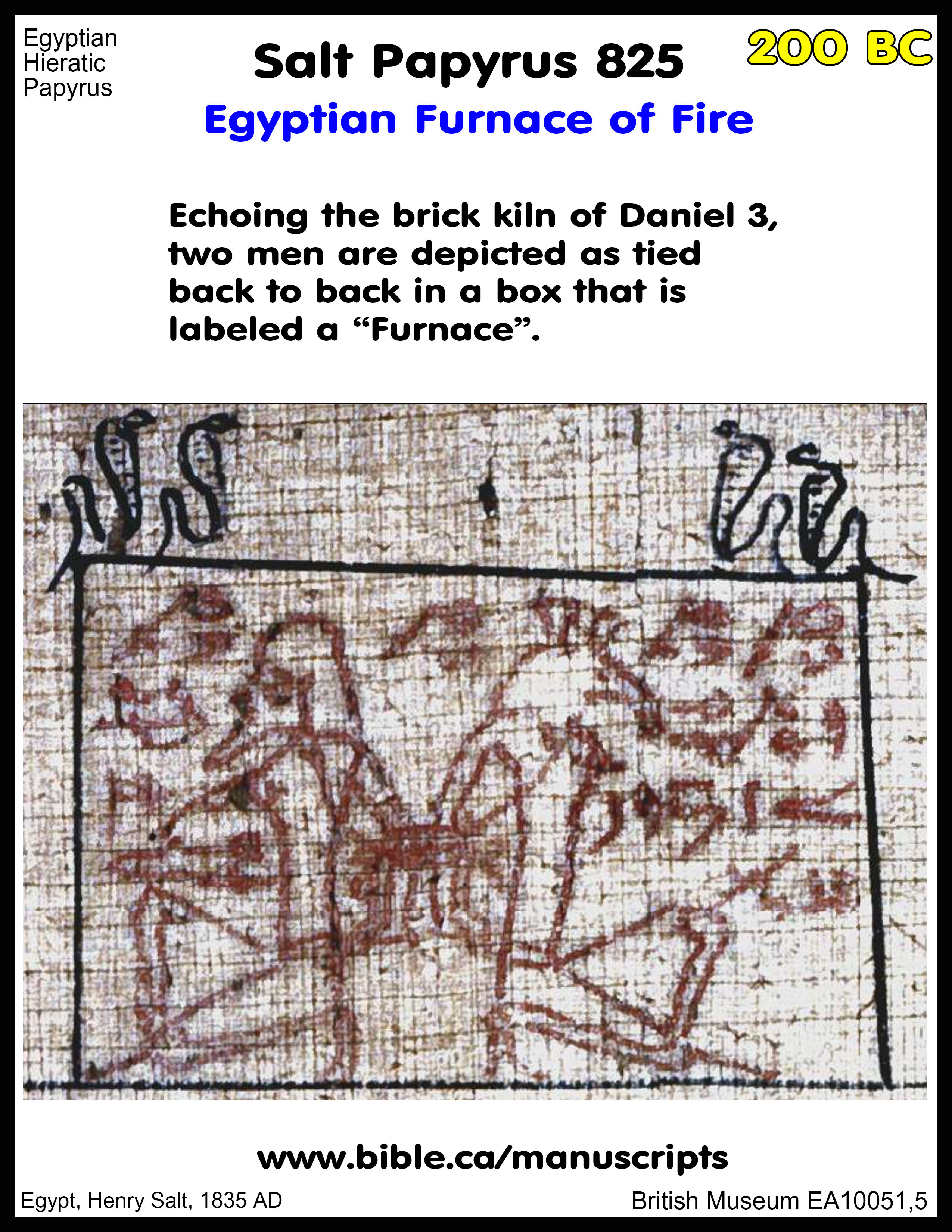
d. “Pharaoh Shabaka, who, taking Pharaoh Bocchoris captive, burned him alive, and reigned for 8 years.” (Manetho chronology, Africanus version, 220 AD)
i. The Hornung/Krauss chronology set the reign of Pharaoh Bocchoris Wahkare (Tefnakht’s successor) at 728–723 BC.
ii. The reign of Bocchoris coincided with the Assyrian captivity of Israel in 723 BC.
e. “Egyptian eschatological texts and scenes thus relate an understanding that the godless are "cooked" in the hereafter. Punishing prisoners or others by burning them to death had the purpose of completely annihilating them both in the present and in the hereafter, as their bodies were needed in the afterlife for judgment. Without a body, there was no judgment. In Hornung's Altiigyptische Hollenvorstellungen, among many depictions of the condemned in hell from the New Kingdom onward, one finds several striking scenes of the damned in ovens or braziers. For instance, a piece of the fifth register of the Book of Gates from Seti l's tomb (Nineteenth Dynasty, thirteenth century B.C.E.) depicts large, rounded ovens or pits called J:,Jdw in which the damned are being punished. A section from the fourth hour of the Book of Caverns from the tomb of Rameses VI (Twentieth Dynasty, twelfth century B.C.E.) depicts an enormous cauldron (wJ:,Jt) in which the souls and flesh of the damned are cooking. This cauldron is shaped like the examples of braziers from funerary architecture, in that it seems composed of a basin balanced on legs. From the Roman period at Akhmim, there is a more Dantesque depiction of a cauldron for roasting people in the netherworld; the pot has bundles and contains a human figure seeming to leap around within it. Furthermore, the Prophecy of the Lamb in its ex eventu predictions mentions a brazier along with heat, inflammation, and a fire of papyrus as an eschatological judgment against the Medes and Greeks.”(Fiery Furnace in the Book of Daniel and the Ancient Near East, Tawny L. Holm, Journal of the American Oriental Society, Vol. 128, No. 1, p95, 2008 AD)
f. Unchaste women burned: “When Sesostris (12th dynasty Egyptian pharaoh, ~1870 BC) died, he was succeeded in the kingship (the priests said) by his son Pheros (unknown king, perhaps “Pheros = pharaoh” and is not a name.) This king waged no wars, and chanced to become blind, for the following reason: the Nile came down in such a flood as there had never been, rising to a height of thirty feet, and the water that flowed over the fields was roughened by a strong wind; then, it is said, the king was so audacious as to seize a spear and hurl it into the midst of the river eddies. Right after this, he came down with a disease of the eyes, and became blind. When he had been blind for ten years, an oracle from the city of Buto declared to him that the term of his punishment was drawing to an end, and that he would regain his sight by washing his eyes with the urine of a woman who had never had intercourse with any man but her own husband. Pheros tried his own wife first; and, as he remained blind, all women, one after another. When he at last recovered his sight, he took all the women whom he had tried, except the one who had made him see again, and gathered them into one town, the one which is now called “Red Clay”; having concentrated them together there, he burnt them and the town; but the woman by whose means he had recovered his sight, he married.” (Herodotus Histories 2.111.1–4, 458 BC)
2. Babylon/Mesopotamia:
a. “Speak to Lu-Ninurta, Balmu-namb,e, Ipqu-Erra, and Mannum-kima-Sin: Thus says Rim-Sin, your lord. Because he cast a boy into the oven, you, throw the slave into the kiln.” (Letter of King Rim-Sin of Larsa, BIN, lines 7-10, 1822-1763 BC)
b. Code of Hammurabi (1755–1750 BC): Death by burning was the sentence for three different crimes. First, if a man loots a burning house, he will be cast into that burning house, (section 25). second, s non-resident woman runs a tavern or drinks beer in a tavern (section 110). Third, a man who commits incest with this death father’s wife (section 157).
c. “she is veiled for her lord. They shall throw them, either the woman or the man, the eye-witness, in the oven.” (Palace edict of the Assyrian king Assur-resa-isi I, Section 19, line 94, 1130-1113 BC)
d. 605 BC: See translation below the letter of Samsu-iluna, pictured at the top of this document.
e. “A few years ago Francis Joannès published a Babylonian judicial chronicle from the Hellenistic period in which three separate cases of sacrilege are reported, one dated to year 34 of the Seleucid era, the other two to the year 90. The chronicle was obviously compiled from excerpts of astronomical diaries. (cf. Astronomical Diaries and Related Texts from Babylonia, Hermann Hunger, 1988 AD) Indeed, the astronomical diary for the year 278 B.C.E. preserves the first case reported in the judicial chronicle with exact parallels of wording. Similar cases can be culled from other diaries. The cases reported always involve thefts of sacred jewelry and other paraphernalia from temples. The punishment involved is almost invariably death by fire (ina isati qalu, "they were consumed by fire"). (Babylonian Background of the Motif of the Fiery Furnace in Daniel 3, Paul-Alain Beaulieu, Journal of Biblical Literature, Vol. 128, No. 2, p281, 2009 AD)
3. The Book of Enoch is an uninspired Jewish book dating to 150 BC which was widely used by Christians in the first century. It describes punishment of the wicked in a place similar to Hell, except you get out after 10,000 years. "I passed by and I saw a place being set on fire night and day, where there are seven mountains made from costly stones, three placed in the east and three in the south. And the ones toward the east were from colored stone and the other one was from pearl stone, and another from stretched stone, and the one against the south from red stone. The middle one of these was in heaven like the throne of God from alabaster stone and the head of the throne from sapphire stone. And I saw burning fire beyond these mountains. There is a place at the end of the great earth: There the heavens will be completed. And I saw a great chasm in the pillar of fire going down and there was no measure to it, neither in depth nor in height. And beyond this chasm I saw a place where there was neither firmament of heaven above, nor earth having lain a foundation below it. Neither was there water under it, nor birds; but there was a place desolate and terrifying. There I saw seven stars like great burning mountains about which I inquired. The angel said, “This place is the end of heaven and earth; this prison was in the stars and in the powers of heaven. And these stars rolling along in the fire are those passing beside the ordinance of the Lord in the beginning of their rising (for the outer place of heaven is empty), because they do not go in their time.” And he was angry with them and bound them up for ten thousand years, until the time of completion of their sins." (Enoch 18:6–16, 150 BC)
4. Dead Sea Scroll: The Thanksgiving Scroll: 50 BC
|
|
|
|
|
Dead Sea Scroll The Thanksgiving Scroll 1QM, 1Q33, 1QWar Scroll 50 BC “The torrents of Satan shall reach to all sides of the world. In all their channels a consuming fire shall destroy every tree, green and barren, on their banks; unto the end of their courses it shall scourge with flames of fire, and shall consume the foundations of the earth and the expanse of dry land. The bases of the mountains shall blaze and the roots of the rocks shall turn to torrents of pitch; it shall devour as far as the great Abyss. The torrents of Satan shall break into Abaddon, and the deeps of the Abyss shall groan amid the roar of heaving mud. The land shall cry out because of the calamity fallen upon the world, and all its deeps shall howl. And all those upon it shall rave and shall perish amid the great misfortune. For God shall sound His mighty voice, and His holy abode shall thunder with the truth of His glory. The heavenly hosts shall cry out and the world’s foundations shall stagger and sway. The war of the heavenly warriors shall scourge the earth; and it shall not end before the appointed destruction which shall be forever and without compare.” (The Thanksgiving Hymns, 1QH, 1QHa Col. xi)
“A source of light shall become an eternal ever-flowing fountain, and in its bright flames all the [sons of iniquity] shall be consumed; [it shall be] a fire to devour all sinful men in utter destruction. (The Thanksgiving Hymns, 1QH, 1QHa Col. xiv)
The Thanksgiving Hymns, 1QH, 1QHa, 50 BC |
|
|
|
5. Dead Sea Scrolls: Rule of the Community: 100 BC
a. God separates all men into two groups for judgement eternal blessing/life and eternal damnation/fire: Mt 25.
b. Last Days, Day of Visitation: AD 70: Lk 19:42-44; Second coming: 1 Pe 2:12
c. The Essenes believed in conscious life after death not extinction: Lk 16:19
d. The Essenes believed in eternal conscious torment and not annihilation: Rev 14:11; 20:10; 25:46; 2 Th 1:9
e. The judgement was executed through angels: Rev 12:7-9
f. There will be a new creation wherein the righteous live: Rev 21
|
|
|
|
|
Dead Sea Scroll Rule of the Community Judgment: Eternal live vs. Eternal Damnation 1QS, 1QRule of the Community (Mt 25, Rev 12:7-9; 20:11-15) 100 BC
“May God’s anger and the wrath of his verdicts consume him for everlasting destruction.” (1QS, Col 2, line 15)
“And in the hand of the Prince of Lights is dominion over all the sons of justice; they walk on paths of light. And in the hand of the Angel of Darkness is total dominion over the sons of deceit; they walk on paths of darkness. From the Angel of Darkness stems the corruption of all the sons of justice, and all their sins, their iniquities, their guilts and their offensive deeds are under his dominion in compliance with the mysteries of God, until his moment; and all their afflictions and their periods of grief are caused by the dominion of his enmity; and all the spirits of his lot cause the sons of light to fall. However, the God of Israel and the angel of his truth assist all the sons of light. He created the spirits of light and of darkness and on them established every deed, [o]n their [path]s every labour «and on their paths [eve]ry [labo]ur». God loves one of them for all eternal [a]ges and in all his deeds he takes pleasure for ever; the other one he detests, his counsel and all his paths he hates forever.” (1QS, Col 3, lines 20-26 to Col 4, line 1)
“These are the foundations of the spirit of the sons of truth (in) the world. And the reward of all those who walk in it will be healing, plentiful peace in a long life, fruitful offspring with all everlasting blessings, eternal enjoyment with endless life, and a crown of glory with majestic raiment in eternal light. Blank However, to the spirit of deceit belong greed, sluggishness in the service of justice, wickedness, falsehood, pride, haughtiness of heart, dishonesty, trickery, cruelty, much insincerity, impatience, much foolishness, impudent enthusiasm for appalling acts performed in a lustful passion, filthy paths in the service of impurity, blasphemous tongue, blindness of eyes, hardness of hearing, stiffness of neck, hardness of heart in order to walk in all the paths of darkness and evil cunning. And the visitation of all those who walk in it will be for an abundance of afflictions at the hands of all the angels of destruction, for eternal damnation by the scorching wrath of the God of revenges, for permanent terror and shame without end with the humiliation of destruction by the fire of the dark regions. And all the ages of their generations (they shall spend) in bitter weeping and harsh evils in the abysses of darkness until their destruction, without there being a remnant or a survivor for them. Blank In these (lies) the history of all men; in their (two) divisions all their armies have a share for their generations; in their paths they walk; every deed they do (falls) into their divisions, dependent on what might be the birthright of man, great or small, for all eternal times. For God has sorted them into equal parts until the last time, and has put an everlasting loathing between /their/ divisions. Deeds of injustice are an abhorrence to truth and all the paths of truth are an abhorrence to injustice. (There exists) a violent conflict in respect of all their decrees since they can not walk together. God, in the mysteries of his knowledge and in the wisdom of his glory, has determined an end to the existence of injustice and on the appointed time of the visitation he will obliterate it for ever. Then truth shall rise up forever (in) the world, for it has been defiled in paths of wickedness during the dominion of injustice until the time appointed for the judgment decided. Then God will refine, with his truth, all man’s deeds, and will purify for himself the structure of man, ripping out all spirit of injustice from the innermost part of his flesh, and cleansing him with the spirit of holiness from every wicked deeds. He will sprinkle over him the spirit of truth like lustral water (in order to cleanse him) from all the abhorrences of deceit and (from) the defilement of the unclean spirit, in order to instruct the upright ones with knowledge of the Most High, and to make understand the wisdom of the sons of heaven to those of perfect behaviour. For those God has chosen for an everlasting covenant and to them shall belong all the glory of Adam. There will be no more injustice and all the deeds of trickery will be a dishonour. Until now the spirits of truth and injustice feud in the heart of man: they walk in wisdom or in folly. In agreement with man’s inheritance in the truth, he shall be righteous and so abhor injustice; and according to his share in the lot of injustice, he shall act wickedly in it, and so abhor the truth. For God has sorted them into equal parts until the appointed end and the new creation. He knows the result of their deeds for all times [everlas]ting and has given them as a legacy to the sons of man so that they know good [and evil … and] to cast the lots of every living being according to his spirit in [… until the time of] the visitation.” (1QS, Col 4, Lines 6-26) 1QS 1QRule of the Community, 100 BC |
|
|
|
Conclusion:
1. The tablet confirms execution by fire in the days of Nebuchadnezzar and the story in Daniel 3 of Shadrach, Meshach and Abed-nego being cast into a brick kiln for refusing to bow to Nebuchadnezzar’s image. Regardless if the tablet dates to 1750 BC or 605 BC, it confirms this odd form of execution.
2. The tablet proves Daniel was written in the 6th century BC, not 150 BC as the skeptics suggest because execution in an industrial kiln was unknown during the Jewish Hasmonean era. While it is true the burning was a known punishment, even the Dead Sea Scrolls, the Jewish literature never had someone thrown into a kiln, except for in the book of Daniel.
3.
There is a type/antitype connection between the literal burning by fire as
punishment for sin in Mosaic, Babylonian, Egyptian, Daniel 3, Enoch 18, two Dead
Sea scrolls, and the symbolic burning in fire, and the final punishment of eternal
conscious torment in hell, the lake of fire pictured most detailed in Luke
16:19-31.

4. What you read in the book you find in the ground!
5. Find me a church to attend in my hometown this Sunday!
By Steve Rudd: Contact the author for comments, input or corrections.
